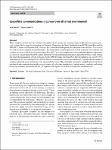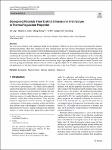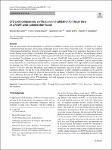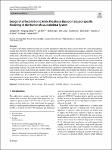Search
Author
- Agnese, Spadi (1)
- Alessandro A., Quarta (1)
- Alexander, Buchholz (1)
- Andrés, Guzmán (1)
- next >
Subject
Search Results
Shallow Hilbert curve patterns with easily programmable texture density were selected for laser texturing of stainless steel substrates. Two different texture path segment lengths (12 and 24 µm) and four different laser power percentages (5%, 10%, 15%, and 20%) were investigated. The textured and smooth substrates were coated with thin polydopamine/polytetrafluoroethylene (PDA/PTFE) coatings for tribological property assessment. The effects of texture density (texture area coverage) and laser power on the durability and friction of the coated surfaces were studied. |
Nine organic compounds were utilized as model lubricants to investigate the impact of functional groups on tribological performances. Nonanoic Acid with carboxyl showed the best lubrication properties, and fluid film and tribofilm were coexistent in its friction test, bringing a low friction coefficient and wear rate. In addition, the lubricant with low friction coefficient corresponded to high adsorption energy in density functional theory (DFT) calculations. And the lubricant forming adsorption film with large surface energy displayed small wear rate in friction test. |
The paper describes how the attitude of a sounding rocket, launch vehicle or satellite with respect to the Earth can be estimated from camera images of the Earth horizon. Details about detecting the horizon in the camera image, fitting hyperbolae or ellipses to the detected horizon curve and deriving the Earth nadir vector and the corresponding error covariance from the fitted conic section are given. The presented method works at low heights, where the projected horizon mostly appears to be hyperbolic, as well as at large heights, where the projected horizon mostly appears to be elliptic and it is irrelevant if the Earth is fully or only partially in the field of view of the camera. |
We present a fast method for nonlinear data-driven model reduction of dynamical systems onto their slowest nonresonant spectral submanifolds (SSMs). While the recently proposed reduced-order modeling method SSMLearn uses implicit optimization to fit a spectral submanifold to data and reduce the dynamics to a normal form, here, we reformulate these tasks as explicit problems under certain simplifying assumptions. In addition, we provide a novel method for timelag selection when delay-embedding signals from multimodal systems. We show that our alternative approach to data-driven SSM construction yields accurate and sparse rigorous models for essentially nonlinear (or non-linearizable) dynamics on both numerical and experimental datasets. |
This is a high-level study into the validation of a unified electric power and communications architecture for modern spacecraft systems. We leverage from blending the European Cooperation for Space Standardisation (ECSS) SpaceWire and the IEEE 802.3 Power over Ethernet (PoE) standards for a common onboard power and communications interface. The focus of the work has been communication performance. The requirements from the protocols of both standards were analysed and combined to create a full protocol stack for SpaceWire PoE. The stack is implemented on an embedded platform represented as a proof-of-concept SpaceWire PoE system. The results of functional testing demonstrate SpaceWire PoE as a valid solution that meets the requirements of both protocols. For the 100 Mb/s links, the... |
In order to demonstrate the relevance of considering Vortex-Induced Vibrations (VIV) in the structural design of marine structures, this study proposes an alternative experimental and analytical approach in wet conditions to measure the fluid–structure interaction in the near field and quantify the viscous damping with measured structural and 3D hydrodynamic accelerations. It was demonstrated that VIV caused and incremented 5.00% of the structural damping coefficient, and the extreme wind loading increased 74% of the offshore monopile’s structural damping, demonstrating the relevance of the high non-linear hydrodynamics effects during selecting parameters into the structural design in offshore applications. |
The structural evolutions of the organisms during the development of billions of years endow them with remarkable thermal-regulation properties, which have significance to their survival against the outer versatile environment. Inspired by the nature, there have been extensive researches to develop thermoregulating materials by mimicking and utilizing the advantages from the natural organisms. In this review, the latest advances in thermal regulation of bioinspired microstructures are summarized, classifying the researches from dimension. The representative materials are described with emphasis on the relationship between the structural features and the corresponding thermal-regulation functions. For one-dimensional materials, wild silkworm cocoon fibers have been involved, and the ... |
With the advancement of high-performance computation capabilities in recent years, high-fidelity modelling tools such as computational fluid dynamics are becoming increasingly popular in the offshore renewable sector. To justify the credibility of the numerical simulations, thorough verification and validation is essential. In this work, preparatory heave decay tests for a freely floating single cylinder are modelled. Subsequently, the surge and sway decays of a linearly moored floating offshore wind turbine model of the OC4 (Offshore Code Comparison Collaboration Continuation) phase II semi-submersible platform are simulated. Two different viscous-flow CFD codes are used: OpenFOAM (open-source), and ReFRESCO (community-based open-usage). |
A variety of prosthetic ankles have been successfully developed to reproduce the locomotor ability for lower limb amputees in daily lives. However, they have not been shown to sufficiently improve the natural gait mechanics commonly observed in comparison to the able-bodied, perhaps due to over-simplified designs of functional musculoskeletal structures in prostheses. In this study, a flexible bionic ankle prosthesis with joints covered by soft material inclusions is developed on the basis of the human musculoskeletal system. First, the healthy side ankle–foot bones of a below-knee amputee were reconstructed by CT imaging. |
The soft robotics field is on the rise. The highly adaptive robots provide the opportunity to bridge the gap between machines and people. However, their elastomeric nature poses significant challenges to the perception, control, and signal processing. Hydrogels and machine learning provide promising solutions to the problems above. This review aims to summarize this recent trend by first assessing the current hydrogel-based sensing and actuation methods applied to soft robots. We outlined the mechanisms of perception in response to various external stimuli. Next, recent achievements of machine learning for soft robots’ sensing data processing and optimization are evaluated. Here we list the strategies for implementing machine learning models from the perspective of applications. Las... |










